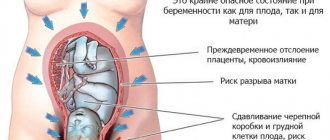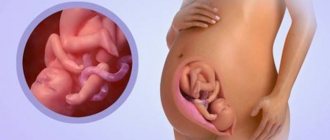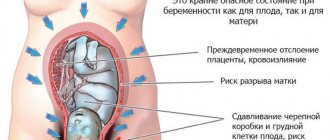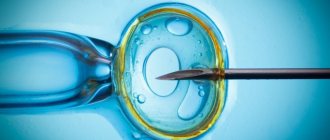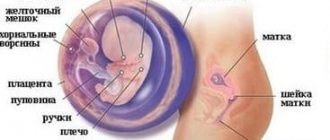The fifth month of pregnancy is ending, and you are approaching the half-term mark. If childbirth occurs at the 40th week, then you still have to walk with your belly for exactly the same amount of time as your pregnancy has already lasted (starting from the period of ovulation). But, despite this, the child’s body in your womb has already formed, grown, strengthened and life is in full swing: a small heart is beating, the kidneys are working hard, it already has all the organs and the main “details”: the limbs, ears are fully formed, eyebrows have appeared , eyelashes and hairs on the head. The eyes are still closed, but he “sees”, and if there are two fetuses, at this stage they are able to distinguish each other’s faces.
Lower back pain at 6 weeks of pregnancy, what to do
Initially, you should consult a doctor so that he can determine the cause of the pain. If there is an exacerbation of osteochondrosis or inflammation of the bone endings, the following measures are indicated:
- use a special bandage or corset for pregnant women as prescribed by the attending physician;
- taking vitamin and mineral complexes;
- if your physical condition allows, then daily physical exercise is recommended (if there is a threat of miscarriage, all exercise is contraindicated);
- static loads are contraindicated;
- food with sufficient vitamin D and calcium (large amounts of the latter are found in fermented milk and fish products, nuts);
- give preference to orthopedic furniture;
- change body position as often as possible;
- eliminate heavy lifting;
- plan the day so that there is enough time for rest and recovery;
- strengthen your back muscles with water treatments (swimming in the pool).
Following these instructions will also be a good way to prevent pain in the lumbar region.
Pulling in the lower back in early pregnancy, looking for the cause
Is it always unfavorable if you have lower back pain in early pregnancy? It is possible that this is a completely physiological phenomenon associated with conception and the transition of the body to a new position. The cause of pain may be worsening chronic diseases or an impending miscarriage. In any case, you cannot do without consulting a doctor.
In order to answer the question of why the lower back is pulled in the early stages of pregnancy, it is necessary to find the reason. If pain appears even before the delay or in the first days after it, then this is caused by the pregnancy itself and the body’s adaptation to it. They usually go away after 10–11 weeks of pregnancy, when the uterus enlarges and rises into the abdominal cavity. In addition, the cause of discomfort in the lumbar region is the transformation of the uterine ligaments and their tension, which is also associated with its growth.
If you experience lower back pain during early pregnancy, this is due to hormonal changes. Progesterone, considered the most important hormone of pregnancy, is produced in large quantities, the growing uterus causes a shift in the center of gravity, and the ligaments and discs softened by progesterone change their structure.
However, lower back pain is not always harmless and is explained by physiological processes inherent in pregnant women. If they are periodic in nature, accompanied by dizziness and weakness, as well as bleeding, then we are talking about an impending miscarriage, which can be prevented.
In addition to termination of pregnancy, pain in the lower back can signal the onset or worsening of the disease. The most common of them are osteochondrosis, pyelonephritis, myositis and other diseases of the spine. In this case, self-medication and the use of conventional medications are prohibited. The doctor should choose treatment based on your situation. Hospitalization is not excluded.
Pyelonephritis or inflammation of the kidneys can be suspected if lower back pain occurs in early pregnancy. This disease is quite common among pregnant women whose body has become infected due to weakened immunity. However, the hallmark of pyelonephritis is pain on one side of the lower back, since in most cases only one kidney is affected. Associated symptoms of kidney inflammation include fever, cloudy urine, and painful urination.
Inflammation of the lumbar muscles or myositis is also common in pregnant women. In this case, it is not recommended to use the usual ointments and painkillers. An opinion from a qualified specialist is required. As you can see, lower back pain in early pregnancy is not always dangerous. But in any case, you need to tell your gynecologist about them in order to exclude various troubles and complications.
Pregnancy with twins by week When a woman’s body develops not one, but several fetuses at once, it is not only magical, but also very responsible. The expectant mother is experiencing...
Why do you feel sick during pregnancy? Morning sickness is one of the most common pregnancy companions. For some women this process is tolerable, for others.
No comments yet!
Popular articles
14 weeks pregnant nipples hurt
Sore nipples during pregnancy: causes Pain in the nipples is one of the symptoms of pregnancy, although it is not necessary. Even before the delay of menstruation.
Increased uterine tone 20 week
Uterine tone in the second trimester The second trimester of pregnancy is the most favorable time for the expectant mother, when toxicosis ends and the woman returns to good health. The only one.
24th week of pregnancy At the 24th week of pregnancy, the proportions of the mother’s body continue to change, the belly and uterus become larger.
Fetus at 20 weeks of gestation: movements, development, weight and size
By the 20th week, the baby reacts to sound and light, is able to grimace and swallow amniotic fluid, hiccups and sneezes, sucks its thumb, plays with the umbilical cord and limbs, urinates, smiles and frowns.
The baby feels good in his tummy. He is warm and comfortable, he is reliably protected from the outside world by the amniotic sac, and his body continues to be covered with vernix lubrication, which protects him from amniotic fluid. At week 20, the skin thickens and, together with the protective mass, becomes four-layered.
By the end of the 5th month of pregnancy, the fetus already weighs over 250 g, closer to 300 g, and its coccygeal-parietal size can exceed 16 cm. Starting next week, fetal growth will be measured from head to toe.
The baby's movements become more and more pronounced and noticeable; by the degree of activity of the baby, the mother can determine whether he is sleeping or awake. While awake, the baby is doing somersaults in her tummy: she pushes off from the wall of the uterus and moves to the opposite wall, waving her arms and legs, which is felt by the mother from the inside. Please note that the baby can now hear everything perfectly: a sharp sound or suddenly turned on loud music can scare him and force him to push his mother.
Already now you should start paying attention to the nature of the baby’s movements and their intensity: excessive activity or, conversely, calmness may indicate that the fetus is not receiving enough oxygen. On average, within 10 minutes the mother should feel at least one push from the inside.
Future mom
The uterus also grows and rises higher, squeezing other organs. Now it has already reached the level of the navel, which is why it may begin to protrude outward - don’t worry, after childbirth everything will return to its place. Meanwhile, your tummy protrudes more and more, and your waist has completely disappeared.
Pulling the lower back in early pregnancy
The state of pregnancy is always its own, new sensations. They are so multifaceted and exciting that any changes in the body make expectant mothers very worried. There are many points that indicate physiological changes in the body and they are considered normal. On the contrary, there are a number of factors that can hide terrible diagnoses. If you have pain in the lower back in early pregnancy, regardless of age and number of previous pregnancies, this is one of the ambiguous signs by which it is impossible to determine whether it is normal or pathological. Some women have no other symptoms, while others may have a high fever, bloody discharge, or changes in the color of the urine.
If we remember our anatomy lessons, then everyone knows that during pregnancy, the expectant mother’s body produces the hormone relaxin. It prepares a woman for childbirth by softening her joint ligaments. The sacrum, which was immobile before pregnancy, becomes mobile, just like the hip joints. In addition, the ligaments of the womb, which support the growing uterus, begin to actively work, which leads to discomfort and answers the question of why the lower back is pulled in early pregnancy in women. This is a physiological and normal condition in the first trimester of pregnancy. Such pain is not pronounced and, as a rule, goes away by the second month of bearing the baby.
When should you see a doctor?
In addition to physiological processes, at the beginning of pregnancy, chronic diseases that the pregnant woman previously suffered from may worsen. As a rule, in addition to pulling the lower back in the early stages, a woman will be bothered by at least one additional symptom. The most common diseases are:
- Pyelonephritis.
This is a kidney disease. It happens that it is practically asymptomatic, and sometimes it is characterized by a very high temperature and painful urination. The pain is usually localized on one side in the lumbar region. - Cholecystitis.
Disease of the gallbladder with or without the presence of stones. Inflammation occurs with the development of pain in the area of the right hypochondrium and its spread under the shoulder blade and into the lower back. Moreover, one of the main symptoms signaling this disease is dark-colored, or “beer-colored” urine. - Osteochondrosis, scoliosis.
These are diseases of the musculoskeletal system. When the center of gravity shifts in pregnant women, as well as with a long-term sedentary lifestyle, the risk of exacerbation of these diseases increases. At the same time, a woman in the early stages of pregnancy experiences lower back pain, and this pain is unlikely to go away quickly without appropriate treatment. - Another reason for lower back pain in the early stages of pregnancy may be an incipient miscarriage.
It is characterized by nagging, cramping pain in the sacrum and lower abdomen. Very often they resemble pain, like during menstruation. In obstetrics, this is considered one of the most dangerous conditions in which a pregnant woman can lose her baby, especially if there is bleeding. In this case, urgent hospitalization is required, and complete rest until the ambulance arrives.
All of the above diseases require consultation with specialists
It is very important to understand that pregnancy is not a normal condition, and any medications can harm this fragile process
So, if in the early stages of pregnancy your lower back is a little tight and the pain is not severe and intermittent, then there is no need to panic. Most likely, this is a physiological process that does not require treatment. But if you have additional symptoms or are very concerned, consult your doctor.
Methods for treating and preventing nagging pain
In some women, due to the individual characteristics of the body, nagging pain persists for a long time and does not indicate the development of any pathologies. At the same time, they cause significant discomfort. In this case, the doctor prescribes minimal dosages of antispasmodic drugs. They help relieve pain from uterine stretching: “No-Shpa”, “Papaverine”. Medicines in the form of suppositories are often used.
In cases where unpleasant symptoms are caused by pathologies or such serious conditions as frozen pregnancy, surgical intervention cannot be avoided.
To prevent pain from appearing, a woman should remember the methods of preventing it:
- performing physical exercises from the first week of pregnancy - there are complexes that eliminate pressure on the stomach and excessive stress;
- if training is contraindicated, the girl should walk in the fresh air;
- wearing a bandage to support the lower back and abdomen - the accessory correctly distributes the increased load.
Proper nutrition
Proper and balanced nutrition in the eighth week of pregnancy is very important, since a woman needs to renew the energy spent on going to the doctor, taking tests, and also needs to find the strength to resist toxicosis. It is recommended to follow the same diet as in previous periods.
Try to eat lean boiled meat, vegetables, fruits and dairy products, because milk is a source of calcium, vitamins and protein. Consumption of kefir and yoghurts contribute to the functioning of the digestive system. It is recommended to consume bread and baked goods in moderation, as intestinal function may worsen
It is recommended to follow the same diet as in previous periods. Try to eat lean boiled meat, vegetables, fruits and dairy products, because milk is a source of calcium, vitamins and protein. Consumption of kefir and yoghurts contribute to the functioning of the digestive system. It is recommended to consume bread and baked goods in moderation, as intestinal function may worsen.
It is strictly forbidden to eat a lot of salty foods, as this causes fluid to be retained in the body, which is why swelling appears, which should not be allowed. It is not recommended to drink strong tea; it is better to replace it with green tea. You should not overeat, eat often when your body requires it, but in small portions. When you come to see a doctor, you will be weighed, if you gain more weight than allowed in a month, you will be prescribed a diet and advised to eat less.
Fetus - norms, sensations, activity
The fetus's facial expressions are improving; now he can blink, yawn and grimace. His mouth periodically opens, the baby makes swallowing movements, drinking a little amniotic fluid. Subsequently, primary feces - meconium - are formed from its components, which is released in the first days of the child’s life.
Fetal parameters at 20 weeks:
- Weight – 270-300 g;
- Body length – 25-27 cm.
The baby's skin now consists of 4 layers, so it is no longer transparent and smooth. Wrinkles appear on its surface, it still retains its red color. The sebaceous glands work intensively, secreting a secretion of vernix lubrication, which protects against the soaking effects of amniotic fluid. The baby's entire body is covered with fluff; in place of hair, eyebrows and eyelashes, it grows more intensively. The fingernails and toenails have already formed.
The baby's lungs are at a developmental stage; after a few weeks, this will allow the baby to imitate the first training breathing movements. This skill will be useful to the baby when he has to take his first breath.
The baby’s nervous system develops and matures, his skills improve - at this stage of pregnancy he can already touch his face and torso with his fingers, suck them, grasp the umbilical cord with his hands, and move around in the uterine cavity.
At week 20, the hearing and visual apparatus of the unborn baby continues to develop. He distinguishes loud sounds and even recognizes his mother's voice by timbre. The eyelids are already able to blink, although before this time the eyes were constantly closed. The first photoreceptors appear on the retina of the eyes.
The fetal heartbeat can be clearly heard with a regular stethoscope. All internal organs function properly.
Why low back pain may occur in early pregnancy
Some expectant mothers, feeling back pain, begin to treat myositis and colds. However, most often, this is not what causes lumbar pain in early pregnancy. In fact, such sensations are not uncommon in the first trimester.
The fact is that, previously immobile, the sacrum and hip joints become more relaxed due to the influence of the hormone relaxin. And the ligaments of the womb undergo softening. In this case, mild pain is completely natural and should not cause any concern to the pregnant woman.
It’s another matter if the pain becomes spasmodic, pronounced, and is accompanied by impaired coordination. This may be evidence of developing symphysitis, which occurs from severe stretching of the pubic muscles, and can lead to internal bleeding. The disease should be treated in a hospital, under the watchful supervision of doctors.
Also, lower back pain in early pregnancy can occur due to a shift in the center of gravity, which is facilitated by a growing belly. To maintain balance, expectant mothers instinctively spread their shoulders and stretch their necks forward. This position increases the load on the lumbar spine and, as a result, pain occurs.
The situation becomes aggravated if the pregnant woman previously suffered from scoliosis, osteochondrosis, muscle atrophy and other diseases of the musculoskeletal system. When spending time passively, pain may occur, radiating to the lower extremities. These pains are quite natural, but can cause serious inconvenience.
If lower back pain in the early stages of pregnancy is accompanied by fever, swelling, dark urine and migraines, this most likely signals worsened infectious or inflammatory processes in the kidneys, genitourinary system or gall bladder. In this case, you should not self-medicate, but should immediately consult a doctor and get tested. If the pain is spasmodic in nature, which affects not only the lumbar region, but also the groin area, the doctor will first of all suspect urolithiasis or renal colic.
But the biggest threat is pain that comes in waves, with a tendency for contractions to intensify. They can be compared to very painful periods or the pain of an intestinal infection. And if at the same time the pregnant woman discovers suspicious brown or brown discharge from the vagina, then this is already a serious cause for alarm. Most likely, this is a signal of an ongoing or impending miscarriage.
Feelings at 20 weeks of pregnancy
As the belly increases, the center of gravity of the expectant mother’s body shifts, her posture and gait change. Due to the increasingly increasing load on the spine, as well as due to the softening of the sacrofemoral ligaments and the expansion of the pelvis, you may now feel a nagging pain in your back. To avoid back problems, it is recommended to consider wearing a special brace, which, however, does not negate the need to continue to strictly monitor your weight, maintain your posture, avoid standing on your feet for long periods of time, and hide high-heeled shoes away in the closet.
Please note that staying on your feet for a long time can provoke another extremely unpleasant, painful problem – calf muscle cramps. The reason for their appearance is not only overwork of the legs, but also a lack of calcium. That is why you should rest your feet every hour, resort to a relaxing foot massage from time to time, and also be sure to monitor your diet, enriching your diet with calcium-containing foods.
It will be useful in case of fatigue and pain in the legs, and in the presence of varicose veins, it becomes a necessity to purchase special compression garments. Constipation, heartburn and bloating that you may experience at this stage are consequences of a “crowded” intestine. The bladder and ureters are compressed, causing possible poor urine flow. If there is no urge to urinate for a long time, you should go to the toilet - this process is now disrupted.
The diaphragm also suffers, so you may feel as if there is not enough air when you inhale. Later, when the uterus goes deep into the pelvis (closer to childbirth), this discomfort will pass.
Bleeding gums, blurred vision, the appearance of pigmentation on the skin - all this can overtake a pregnant woman at 20 weeks of pregnancy. These phenomena are all temporary: pigmentation will disappear after childbirth, vision will be restored. But it is still possible to combat bleeding gums by resorting to rinsing with decoctions of oak bark, chamomile, and sage.
Pay attention to the degree of swelling, which may also occur at this stage of pregnancy. Minor swelling is not dangerous and is only a consequence of fluid retention in the body. But severe swelling is an alarming symptom, with which it is better to consult a doctor.
From the 20th week, the woman will begin to gain weight sharply: the baby begins to accumulate fat, which, of course, cannot but affect the mother. It is not surprising that during this period there is a noticeable increase in appetite, but weight still needs to be strictly controlled.
More on the topic
Fetal development at 12 weeks of pregnancy
What to do if you have a small belly during pregnancy and it doesn’t grow?
Fetal development at 14 weeks of gestation
Why can your stomach itch in early and late pregnancy?
Ultrasound at 32 weeks of pregnancy
Under no circumstances should you sleep on your back. Most likely, you are already communicating with your baby in full swing - he will tell you which mother’s position is most comfortable for him. If there are no contraindications, do physical exercises for pregnant women. Watch your diet and the quality of food you consume. Iron and calcium are still important.
Be sure to use moisturizing body creams or special products to prevent stretch marks. And remember about correct posture, comfortable shoes and optimal work and rest mode. Enjoy your position and don't overwork yourself.
Source of pain infection
The infectious process can be in the tonsils, on the dermis, in teeth susceptible to caries or in internal organs. Also, the cause of disruption of the normal functioning of the kidneys can be neoplasms that may not appear for a long time.
Pain syndrome occurs when the kidney capsule becomes tense as a result of strong pressure from the tumor. The signs of this process are:
- the presence of red blood cells, pus and mucus in urine;
- a blood test reveals an increased content of leukocytes, a high ESR (erythrocyte sedimentation rate);
- general malaise, weakness, increased sweating.
To summarize, a weak, nagging pain in the lumbar region at the very beginning of a woman’s interesting position is considered natural. In all other cases, this is a signal to seek medical help.
Diagnostic methods
The examination of the girl begins with a visit to the gynecologist in the absence of acute symptoms. If a woman is admitted to the hospital complaining of severe pain, an emergency diagnosis is performed.
The most common method that helps identify pathologies in the absence of severe pain is ultrasound. At 20 weeks of pregnancy, he may be prescribed for a routine assessment of the process of gestation. With its help, it is determined whether the child is developing normally and whether its size corresponds to its age. The study allows you to assess the amount and condition of amniotic fluid, as well as analyze the placenta.
Using an ultrasound, the doctor reveals how well the internal organs of the fetus are developing: stomach, bladder, kidneys, lungs, intestines, liver, heart. At this stage, suspicions of pathologies may arise that will require additional research.
Causes of no concern
Physiological processes during childbearing are significant and often make themselves felt. There are a number of factors that can trigger nagging back pain and are directly related to pregnancy:
- The process of implantation of the fertilized egg. At this time, the woman does not yet know that she is pregnant. The attachment of the egg begins on days 5–7 after fertilization. In addition to the unpleasant sensations in the back, at this time there may be a tightening in the lower abdomen, and pinkish discharge is also acceptable. The condition does not require treatment and quickly goes away on its own.
- Increased blood flow to the pelvic organs. This occurs at about 6 weeks due to the formation of the uteroplacental circulation. The blood vessels become congested and can cause discomfort in the lower abdomen and lower back.
- Softening of ligaments and joints. The body prepares in advance for the birth process by producing the hormone relaxin. It makes cartilage fibers elastic. In this case, the back is usually pulled in the area of the tailbone and lower back.
- Braxton-Higgs contractions. This phenomenon can be observed after 11–12 weeks of pregnancy. The sensations are reminiscent of labor contractions, only with low intensity, and they pass quickly. At this moment the uterus becomes hard and may stretch the back a little.
All these are signs of a normal pregnancy.
You should report this symptom at your scheduled appointment with your doctor. Only he can judge whether diagnostic measures are necessary, taking into account the pregnant woman’s medical history.
Kinds
Most often, it is easier to diagnose the cause of pain in the lower abdomen or back by its correlation with the type of sensation. This practice makes it more likely to find the real focus of the disease and eliminate obviously incorrect assumptions.
Pulling
This kind of pain in the lower back can occur due to physiological or pathological reasons. For physiological causes, symptoms may include:
- germination of blood vessels to supply the fetus with blood;
- increased blood flow to the uterus;
- increased production of relaxin;
- increase in uterine size.
Pathological symptoms include:
- possible miscarriage;
- hydatidiform mole, indicating the absence of a fetus as such;
- ectopic pregnancy;
- uterine fibroids;
- kidney problems;
- lack of pregnancy development because the embryo died.
Important ! The listed symptoms can occur either individually or in combination. The likelihood of occurrence is regulated by the woman’s health status before pregnancy.
Aching
Aching pain in the lower back and abdomen usually appears after the 37th week . This happens due to the fact that false contractions begin, through which the body begins to prepare for childbirth. During contractions, the abdominal cavity tenses, maintaining itself in this state for some time.
Sharp
The presence of sharp pain is argued for two reasons: osteochondrosis and severe stress on the back. In the first case, you need to contact a neurologist, following all the recommendations regarding back care . In the second, it is recommended to completely reduce the entire load on the back to nothing. If these problems are ignored, a miscarriage is possible.
Burning
Burning pain in the lower back, like sharp pain, is a manifestation of various pathologies. However, only if the pain was present before pregnancy. In the case of burning pain during pregnancy, the first suspicions fall on too high a load on the spine .
It is associated with compression of the nerve roots due to incorrect body position. It also increases muscle tone and, in rare cases, stiffness in the lower back, making it impossible to turn painlessly.
Shingles
Pain of this type is most often a consequence of pancreatitis. This pathology is an inflammation of the pancreas and is characterized by the presence of pain in the upper abdomen, both sides of the hypochondrium and girdle pain in the lower back .
Numb
Numbness in the lower back is a consequence of osteochondrosis or other neurological causes . It is usually accompanied by a dull pain, which negatively affects the quality of diagnosis.
Pressing
The main cause of pressing pain is the baby's head, which rests on the lower back. Typically, its manifestations occur at the stage characterized by the 20th week and beyond. In rare cases, pain may begin before the 20th week .
Giving
Attention ! Radiating pain is associated with the passage of a stone through the ureter. The most characteristic symptom is passive lumbar pain radiating to the leg or hip.
Alternative medicine
If you absolutely refuse to take medications, you can try the following methods to relieve pain:
- aromatherapy;
- acupuncture;
- homeopathy;
- manual therapy;
- reflexology.
If a woman was planning a pregnancy and prepared herself for this event in advance: strengthening her muscles, eating healthy food, then she is unlikely to encounter such a problem as lower back pain. But even if you are overtaken by this unpleasant phenomenon, just strictly follow the doctor’s recommendations. They will help cope with pain. Feeling good is a guarantee of excellent mood throughout the 9 months of pregnancy.
Analyzes and their frequency
From this date, the woman attends the antenatal clinic not monthly, but once every 2 weeks. Before visiting the doctor, she takes a general blood and urine test. Additionally, a blood test may be required to check blood sugar and hemoglobin levels. A urine test allows you to assess the condition of the kidneys, which bear an increased load during this period.
If a woman has not yet undergone second trimester screening, she will be prescribed a biochemical blood test to determine possible pathologies of fetal development - a “triple test” for the concentration of the hormone hCG, alpha-fetoprotein and free estriol.
Prevention and treatment
Drug treatment while carrying a child is in most cases prohibited. Even local painkillers are contraindicated. To prevent or eliminate back pain during pregnancy, you need to follow simple recommendations:
- Try to keep your back straight. Correct posture is the best prevention.
- Constantly change the position of the body in space. Staying in the same position for a long time can negatively affect your back muscles and spine.
- Do not lift heavy objects. This can cause not only back pain, but also premature birth. Any stress should be avoided.
- Do exercises for pregnant women. These are simple complexes that will help make pregnancy easier for the woman herself. Walking in the fresh air will also be useful.
- Take a massage course. It must be performed by a specialist, since during pregnancy the massage technique differs from the usual one.
- Choose the right shoes. It is unacceptable to wear shoes that are ill-fitting, uncomfortable or have high heels.
- Non-pharmacological means. A honey compress or a warm scarf on the lower back can relieve pain without harming the baby.
Most often, during pregnancy, the lower back is pulled for completely natural reasons that do not require special treatment. But still, if there are accompanying symptoms or the pain is severe, a consultation with a gynecologist is required. In case of serious violations, medications may be used. Self-medication is strictly prohibited, as it is dangerous for the child’s health.
https://youtube.com/watch?v=_7v_jw6w-Tc
Diseases of internal organs
Pathologies of internal organs, just like problems with the spine, negatively affect the lower back. However, the main problem with diseases of internal organs during pregnancy is that they are more difficult to treat. The medication method is not always suitable, and the consequences if used incorrectly are too high .
Kidneys
Pain in the kidneys very often affects the lumbar region due to their close location. The causes of the disease can be pathologies or the consequences of high load on internal organs. In the case of pathologies, the most popular ones are noted:
- Nephritic syndrome is an inflammation of the structural cells of the kidney.
- Nephrotic syndrome is a consequence of a disorder of the immune and endocrine systems.
- Pyelonephritis is an inflammation that affects the calyx and pelvis of the kidney.
- Renal failure is the loss of the kidneys’ ability to form and excrete urine, causing disturbances of a water-salt or acid-base nature.
Treatment of these pathologies occurs through medications . It is especially important that a woman is not allergic to them, since this can also disrupt the condition of the fetus.
Bladder
If the inflammation concerns the bladder, then in most cases it is cystitis. It is an infectious disease that can negatively affect both the pregnant woman and the fetus.
The cause of such a dangerous pathology is E. coli. It is easy for infected bacteria to enter the body through the urethra, since it is located next to the anus.
Attention ! In the case of pregnancy, the cause may also be a sharp decrease in the body's immunity, allowing bacteria to multiply two or even three times faster.
Symptoms of bladder inflammation include:
- frequent urination;
- false urination;
- burning during or after urination;
- urine contains signs of hematuria or pyuria.
When the pathology enters a severe stage, the woman experiences regular bouts of vomiting and nausea.
Gastrointestinal pathology
Suspicions of the presence of gastrointestinal pathology during pregnancy are very common. However, it is extremely difficult to diagnose and confirm the deviation of processes in the body from the norm. The symptoms and consequences of the disease include back pain , which makes the patient’s daily life difficult.
The cause of the pathology is:
- altered gastrointestinal motility due to pregnancy;
- high pressure of the uterus and fetus;
- vomiting (however, diagnosis based on this symptom is unacceptable due to the fact that it is a characteristic sign of pregnancy);
- heartburn or reflux,
- abdominal pain, constipation and diarrhea.
Pathology may also be accompanied by bleeding, which characterizes a dangerous degree of pathology . After all, most often this is rectal bleeding, indicating the presence of hemorrhoids.
Myositis
Pathology is an inflammatory process localized in the neck, chest or hips. Due to the fact that myositis covers a whole complex of muscles, severe pain in the lower back occurs. It is also strengthened by the fact that the fruit knocks down the center of gravity . Symptoms also include increased muscle tightness due to constant tension, chest and neck pain, and swelling in some areas.
The causes of myositis are a huge number of factors, but the main ones come down to only a few:
- muscle injuries and regular overstrain of the body due to physical activity;
- infectious diseases;
- metabolic disorders.
By taking preventive measures from these sources, it is possible to prevent the occurrence of myositis or its further development.
Reference . The consequences of myositis primarily affect the mother who is bearing the child. She constantly feels weakness, headache and shortness of breath. It is also characteristic that if left untreated, myositis can develop into a chronic stage, leaving muscle weakness for life.
Gynecology
The most popular gynecological disease, which is characterized by back pain during pregnancy, is inflammation of the ovaries. This inflammation affects the female reproductive glands. The peculiarity is that quite often inflammation manifests itself during pregnancy, at the very peak of a decline in the immune system. While in the period before pregnancy, there are usually no symptoms.
Treatment is carried out exclusively by doctors with extensive experience . This is due not only to the fact that the drug treatment method involves complete avoidance of allergens, but also to the fact that there are a number of unforeseen cases. It is in situations where a difficult decision needs to be made that an experienced doctor will be able to do it correctly.
In case of exacerbation of the ovaries, the woman is hospitalized , as this can disrupt the condition of the fetus. Treatment in this situation occurs intravenously, followed by changes in the entire lifestyle. Physiotherapy and gynecological massage are also prescribed.
It is worth noting that if the cause of ovarian disease is microorganisms caused by sexually transmitted diseases, then doctors recommend terminating the pregnancy.
Otherwise, it may negatively affect the child in the future.
Prevention of inflammation involves the prevention of all sexually transmitted diseases, hypothermia and hygiene.
The main task of pregnant women is proper nutrition, adherence to daily routine and rest.
Dangerous pain in the lower back
Unfortunately, the state of pregnancy carries no small danger. This is due to a natural decrease in immunity, so that the body is unable to reject the fetus as something foreign. Low immunity can become fertile ground for the development of many diseases.
- Risk of miscarriage. For various reasons, there may be a threat of premature termination of pregnancy. The condition is accompanied by severe nagging pain and dark discharge. Bloody discharge may also appear in the 9th week of pregnancy if the sciatic nerve puts too much pressure on the uterus. This phenomenon does not threaten the unborn baby, but you should immediately seek help from a doctor to eliminate the danger.
- Inflammatory kidney diseases. Pyelonephritis is a frequent “guest” in expectant mothers. In this case, pain most often appears on one side. Also associated with fever, cloudy urine, swelling of the legs after sleep and discomfort when emptying the bladder.
- Exacerbation of spinal diseases. For example, osteochondrosis. The greatest danger is that the medications are not intended for pregnancy, so it is extremely difficult to help the spine.
- Any disease that the woman had before may also worsen.
Discharge
Discharge at the 20th week of pregnancy most often becomes somewhat more abundant than before. However, you should not worry about this if the discharge is uniform in consistency, has a light gray or milky tint, does not emit any sharp unpleasant odor and does not cause discomfort. The increase in the amount of discharge during this period is associated with the “activity” of the hormone estrogen, which both affects the amount of leucorrhoea and dilutes it somewhat. If you want to slightly influence the discharge and get rid of the problem of wet panties, try washing your face not with plain tap water, but with boiled water and chamomile infusion.
If there is a change in the quality and consistency of the discharge - if green or yellow, purulent, sharply and unpleasantly smelling discharge appears, curdled discharge or with admixtures of flakes, foam - you should immediately consult a doctor. Any change in discharge in this direction indicates the development and progression of a genital infection. It can be caused by fungi of the genus Candida, chlamydia, trichomonas, and usually, in addition to changes in the pattern of discharge, it is also accompanied by discomfort in the genital tract.
An immediate response in the form of calling an ambulance is required by the appearance of brown or bloody discharge, accompanied by abdominal pain. Separation of blood from the vagina or spotting that appears against the background of nagging, spasmodic pain in the abdomen is a sign of uterine hypertonicity and the associated risk of premature termination of pregnancy. Moreover: if your stomach has been hurting for a long time, and even spotting appears, it is possible that a miscarriage has already begun. Therefore, if such a situation exists, call an ambulance immediately.
If blood or brown discharge on panties is observed sporadically in a pregnant woman, occurring after sexual intercourse or a gynecological examination, and is not accompanied by abdominal pain, most likely, cervical erosion is occurring. But even here you cannot do without an additional examination by a doctor.
Ultrasound at 20 weeks of pregnancy
Ultrasound examination at this time is usually carried out as part of the second screening. An ultrasound at 20 weeks of pregnancy may be needed to assess the progress of pregnancy, determine the sex of the child, the likelihood of malformations and chromosomal abnormalities. Also, an ultrasound at the 20th week of pregnancy allows you to determine whether the size of the fetus corresponds to the gestational age, whether the condition of the amniotic fluid and placenta is normal.
When performing an ultrasound at the 20th week of pregnancy, the internal organs of the baby are also examined: kidneys, stomach, bladder and gall bladder, liver, lungs, intestines. The baby's heart is also subject to careful examination - if any discrepancy is detected, a specialized ultrasound examination of the heart will be required. Unfortunately, heart defects are one of the most common fetal malformations today.
In addition to the fact that ultrasound will help assess whether the baby’s development is normal, an ultrasound at the 20th week of pregnancy will also show: the baby is actively growing and developing in the womb. And yet, it doesn’t get bored at all, because its size still allows it to move freely in the mother’s tummy, which the baby actively uses, turning over and tumbling.
Especially for beremennost.net – Elena Kichak


